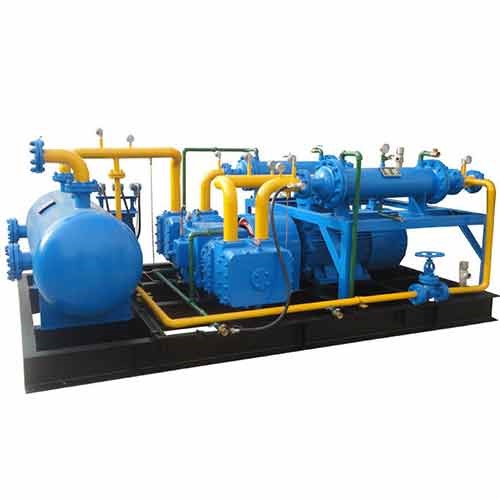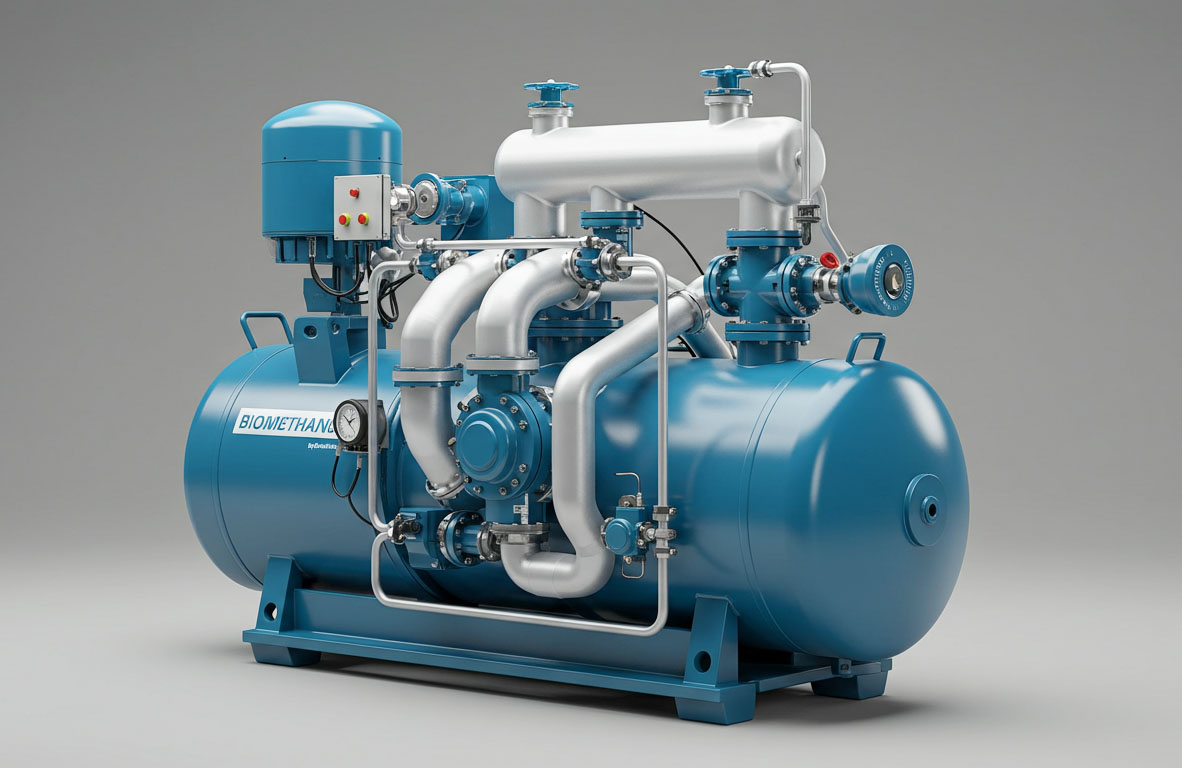HST Compressor: The Ultimate Guide to High-Speed Turbocompressors
HST compressors are widely utilized across various industries. HST stands for High-Speed Turbocompressor, a single-stage centrifugal compressor providing oil-free low pressure air. HST compressors are known for their energy-saving designs which help minimize energy use and lower treatment plant energy bills.

HST compressors are versatile compressors used in applications as diverse as wastewater treatment, aeration, diffusion, filtration and processing. Their wear-free design makes operating them straightforward while their magnetic bearings allow for flexible configuration options for easier operation. They’re available with both electric start motors and various types of start motors to complete the package.
Key Takeaways
- HST compressor is a single-stage centrifugal compressor that provides oil-free, low-pressure air.
- HST compressors are energy-efficient and minimize energy consumption, making them ideal for wastewater treatment and other applications.
- The HST compressor is available in different configurations, including magnetic bearings and various types of start motors.
HST Compressor Overview
Function and Importance
An HST compressor is a high-speed turbocompressor used widely across various industries such as wastewater treatment, refrigeration, and air separation. Its primary purpose is compressing gaseous materials (most often air) at high pressures for various uses in various sectors – this may be used for aeration in wastewater treatment systems, cooling in refrigeration applications or as feedstock for air separation plants.
HST compressors stand out with their superior efficiency and reliability, thanks to their advanced design featuring magnetic bearings and high-speed motors driven through frequency converters – creating unrivaled energy savings while ensuring minimal wear-and-tear. Plus, being wear-free means they provide cost-effective solutions across various industries.
Design Principles
HST compressor design principles center around magnetic bearings and high-speed motors. Magnetic bearings offer contact-free suspension of the rotor for reduced friction and wear resulting in optimal efficiency with minimal maintenance costs. Furthermore, high-speed motors are controlled via an on-board frequency converter to enable variable speed operation with precise control over output output of the compressor.
HST compressors feature vertically mounted air ends with integrated shaft-mounted fans for air cooling of their motors and protected windings via Pt100 sensors that are monitored by local control systems. Available models range from HST 100 to 4000 with maximum flows up to 40,000m3/hour and pressure ratios reaching up to 4.5.
HST compressor is a high-speed turbocompressor used widely across industries due to its efficiency and reliability. Using magnetic bearings with its high-speed motor ensures maximum energy savings while maximizing productivity.
Types of HST Compressors
HST compressors, or high-speed turbocompressors, are widely used industrial applications. Configured to achieve maximum efficiency and reliability, HSTs are popular choices among industries and come in two main varieties – axial compressors and centrifugal compressors.
Axial Compressors
Axial compressors are specifically designed to handle large volumes of air at relatively low pressure ratios, making them popular choices in applications like ventilation, air conditioning and refrigeration. Axial compressors feature rotating blades which compress air as it flows through them – these blades are mounted on a high speed rotating rotor; air enters at the center and is forced outward by these rotating blades as it travels further out from there, increasing pressure along its path towards its edges.
Centrifugal Compressors
Centrifugal Compressors Centrifugal compressors are built for higher pressure ratios than their axial counterparts, and are often seen in applications like gas turbines, oil refineries and chemical processing plants. Centrifugal compressors utilize multiple rotating impellers mounted on a shaft that rotates at high speed to compress air; entering through its center, air enters through an opening at its core before being forced outward by these impellers, increasing pressure as it moves towards its edges.
HST compressors generally fall into two main categories, including axial compressors and centrifugal compressors. Each type has their own set of advantages that make them suitable for specific applications; axial compressors excel at handling large volumes of air at lower pressure ratios while centrifugal models offer higher ratios.
Operational Mechanics
Compression Stages
The HST turbocompressor uses magnetic bearings and a high-speed motor with an integral frequency converter to compress air efficiently at high speeds. Its unique design enables it to run at such high speeds while still remaining efficient; multiple stages of compression increase air pressure as it passes through, with each stage designed to minimize energy use while increasing pressure at each stage of compression. Furthermore, the compressor comes equipped with a variable speed drive for precise control over its compression process.
Temperature and Pressure Control
The HST turbocompressor has advanced temperature and pressure control systems that ensure efficient and reliable operation. The compressor is equipped with a built-in frequency converter that allows for precise control of the motor speed, which in turn controls the compression process. The temperature control system ensures that the compressor operates within safe temperature limits, while the pressure control system ensures that the compressor operates at the desired pressure levels.
To maintain optimal performance, the HST turbocompressor requires regular maintenance and monitoring. This includes regular inspection of the bearings and motor, as well as monitoring of the temperature and pressure control systems. By following the recommended maintenance schedule, the HST turbocompressor can provide reliable and efficient operation for many years.
In summary, the HST turbocompressor uses advanced technology to ensure efficient and reliable compression of air. With its multiple stages of compression and advanced temperature and pressure control systems, the compressor is able to provide precise control of the compression process. Regular maintenance and monitoring are essential to maintaining optimal performance.
Maintenance and Troubleshooting

Routine Maintenance Procedures
To ensure optimal performance and longevity of the HST compressor, routine maintenance procedures should be followed. The following table lists the recommended maintenance procedures and their frequency:
| Maintenance Procedure | Frequency |
|---|---|
| Check oil level | Daily |
| Change oil | Every 3 months or 2,000 hours of operation, whichever comes first |
| Inspect and clean air filters | Every 3 months or 2,000 hours of operation, whichever comes first |
| Inspect and clean heat exchangers | Every 6 months or 4,000 hours of operation, whichever comes first |
| Inspect and clean intercoolers | Every 6 months or 4,000 hours of operation, whichever comes first |
| Inspect and clean aftercoolers | Every 6 months or 4,000 hours of operation, whichever comes first |
| Inspect and clean water-cooled condensers | Every 6 months or 4,000 hours of operation, whichever comes first |
| Inspect and clean oil coolers | Every 6 months or 4,000 hours of operation, whichever comes first |
It is important to note that the maintenance schedule may vary depending on the specific model and usage of the HST compressor. Refer to the manufacturer’s manual for the recommended maintenance schedule.
Common Issues and Solutions
Despite regular maintenance, issues may still arise with the HST compressor. The following list outlines some common issues and their solutions:
- High vibration levels: High vibration levels can be caused by a number of factors, including unbalanced rotors, misalignment, worn bearings, or loose bolts. It is important to identify the root cause of the high vibration levels and address it accordingly. This may involve rebalancing the rotors, realigning the compressor, replacing worn bearings, or tightening loose bolts.
- High oil consumption: High oil consumption can be caused by a number of factors, including worn piston rings, worn valve guides, or a damaged oil cooler. It is important to identify the root cause of the high oil consumption and address it accordingly. This may involve replacing the worn piston rings or valve guides, or repairing or replacing the damaged oil cooler.
- Low discharge pressure: Low discharge pressure can be caused by a number of factors, including a clogged air filter, a damaged intercooler, or a worn compressor valve. It is important to identify the root cause of the low discharge pressure and address it accordingly. This may involve cleaning or replacing the clogged air filter or damaged intercooler, or repairing or replacing the worn compressor valve.
By following the recommended maintenance procedures and addressing any issues promptly, the HST compressor can provide reliable and efficient operation for years to come.
Advancements in HST Compressor Technology

HST compressors have come a long way since their introduction. Advancements in technology have led to improvements in both performance and efficiency. This section will explore some of the most notable advancements in HST compressor technology.
Material Innovations
One of the most significant advancements in HST compressor technology has been the use of new materials in their construction. The use of lightweight, high-strength materials has allowed for the development of more compact and efficient compressors. For example, some HST compressors now use carbon fiber reinforced polymers (CFRPs) for their impellers, which allows for higher rotational speeds and greater efficiency.
Efficiency Improvements
Another area where HST compressor technology has advanced is in its efficiency. New designs and technologies have allowed for compressors to operate at higher speeds and with greater efficiency. For example, some HST compressors now use active magnetic bearings, which eliminate the need for oil lubrication and reduce energy loss due to friction. Additionally, some compressors now use variable frequency drives (VFDs) to control motor speed, which allows for greater energy efficiency and reduces wear on the compressor.
Overall, these advancements in HST compressor technology have led to compressors that are more efficient, reliable, and compact. As technology continues to improve, it is likely that we will see even greater advancements in HST compressor technology in the future.
Frequently Asked Questions

What are the typical applications for high-speed turbo compressors?
High-speed turbo compressors, such as Sulzer’s HST compressors, are widely used in a variety of industrial and municipal applications. They are commonly used in wastewater treatment plants, low-pressure industrial processes, and oil-free compressed air systems. HST compressors are also used in the food and beverage industry, pharmaceuticals, and chemical processing plants.
How do Sulzer’s turbocompressors differ from conventional compressors?
Sulzer’s HST turbocompressors differ from conventional compressors in several ways. They feature an advanced design with proven magnetic bearing technology and a high-speed motor driven through a built-in frequency converter. This design allows for unbeatable efficiency, reduced noise levels, and a smaller footprint. HST compressors are also oil-free, which eliminates the need for oil changes and reduces maintenance costs.
What maintenance requirements are common for HST compressors?
Maintenance requirements for HST compressors are minimal due to their advanced design and oil-free operation. However, regular inspection and cleaning of the compressor’s air filters and heat exchangers are recommended to ensure optimal performance. Additionally, regular monitoring of vibration levels and bearing temperatures can help identify potential issues before they become major problems.
Can Sulzer HST compressors be used in both industrial and municipal settings?
Yes, Sulzer’s HST compressors can be used in both industrial and municipal settings. They are commonly used in wastewater treatment plants, low-pressure industrial processes, and oil-free compressed air systems. HST compressors are also used in the food and beverage industry, pharmaceuticals, and chemical processing plants.
What are the efficiency benefits of using an HST compressor over other types?
The efficiency benefits of using an HST compressor over other types are significant. HST compressors feature an advanced design with proven magnetic bearing technology and a high-speed motor driven through a built-in frequency converter. This design allows for unbeatable efficiency, reduced noise levels, and a smaller footprint. Additionally, HST compressors are oil-free, which eliminates the need for oil changes and reduces maintenance costs.
How does the design of a Sulzer TTMC pump integrate with HST compressor technology?
The design of a Sulzer TTMC pump integrates seamlessly with HST compressor technology. The TTMC pump is designed to work in conjunction with HST compressors to provide efficient and reliable pumping solutions. The integration of these technologies allows for reduced energy consumption, lower maintenance costs, and improved overall system performance.


